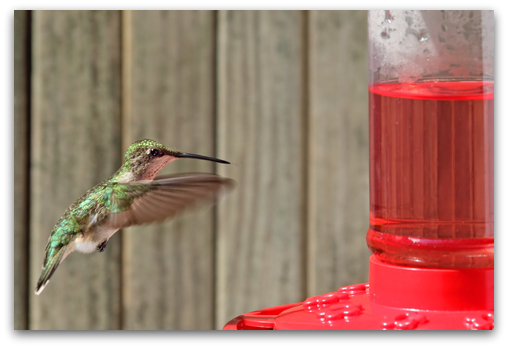Hummingbird Food & Feeder Tips

The best hummingbird food is a mixture of what you place in your feeders and what types of plants and flowers you add to your garden.
Yes, feeders are available in an immense variety of styles and colors.
They range from the straightforward to the whimsical.
However, there’s no such diversity when it comes to what to feed hummingbirds.
Hummingbirds rely on nectar and insects for their sustenance. The former provides the energy they need while the latter gives them protein.
While the definition of nectar can be extended to include all kinds of sweet syrups, (such as honey), in essence it’s really just sugar water. By the way, don’t ever feed your buzzing friends honey! It lends itself to mold creation.
So, What’s Best?
With all the commercially available syrups and nectars for bird feeders I realize it can be difficult to know what to feed hummingbirds.
Many of these concoctions advertise themselves as organic and often utilize alternative sugar sources such as agave. While such preparations might claim to be based on a special hummingbird recipe it’s generally best to avoid them.
By far the best and most cost effective way of filling your feeders is to use sugar syrup that you make at home.
Hummingbird Food Recipe
The recipe for sugar syrup is very simple.
Place a little over four cups of boiling water in a bowl. Add one cup of pure granulated white cane sugar and stir well until completely dissolved.
Refrigerate overnight. When it has cooled you can fill your feeders.
Some folks believe adding red dye or food coloring to the syrup attracts birds. This is simply not true. In fact, coloring agents can harm birds and should be avoided.
It’s also important to use only granulated white sugar when preparing your hummingbird food recipe. I don’t recommend using any artificial sweeteners, sugar substitutes, or alternative sugar sources. I say this primarily because such substances can negatively impact a bird’s health.
Quick Feeder Tips
It’s best to use more than one hummingbird feeder.
These little high-energy creatures are territorial. Once a male hummingbird claims your feeder as his he’ll chase others away.
Be sure to use two or three feeders so you can place them at varying places around your yard or garden. Make sure they can’t be easily seen from one another. This provides a better opportunity to attract a variety of flying jewels.
If you place at least one feeder near a side window of your home (one that’s quiet and free from neighborhood noise/activity) you’ll increase your chances of watching as your hummers feed.
Maintain your feeders by cleaning them every few days. If you don’t you’ll run the risk of accumulating mold and your hummers will leave.
When Do Hummingbirds Eat?
Hummingbirds expend a lot of energy when they beat their wings so they require a lot of food to meet their caloric needs.
They typically feed from just before dawn to just after dusk.
Throughout the course of the day they feed almost constantly. Most birds feed an average of ten to twelve times per hour. Nighttime is the only period of the day when they don’t eat.
Although hummingbirds do eat throughout the day their favorite feeding times are in the morning and towards the late evening. They eat in the afternoon as well but their ingestion levels are somewhat decreased during this period.
Moving Beyond Feeders
I can’t recommend enough moving beyond feeders and growing your own hummingbird garden. It’s a fun and rewarding experience both for you and your hummingbirds.
For you there’s a great sense of accomplishment when you see your hummers taking advantage of what you’ve created. For the lovely little birds there’s the added benefit of natural nectar from your planted flowers.
Your bushes and trees provide them nesting areas as well as shelter for resting between feeding.
Combining feeders and a garden is a wonderful way to provide the proper hummingbird food to these hovering, exciting little birds.
Subscribe to my updates!
Hummingbirds > Hummingbird Food




